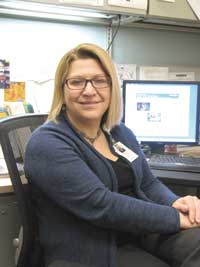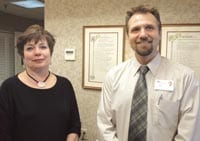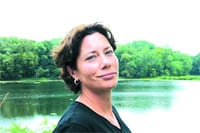At a Crossroads – Aging Population Creates Myriad Healthcare Challenges
It’s no secret that the nation’s demographics are skewing older. Paul Judd doesn’t think that’s all bad.
“People talk about aging of America, but it sure beats the alternative, which is not aging,” said Judd, vice president of Talent Acquisition and Workforce Planning for Baystate Health.
That said, the aging trend is no laughing matter for the healthcare industry, which faces a number of challenges directly related to the fact that Americans are living longer, often with multiple and chronic health conditions, than ever before, and the massive Baby Boom generation — all 75 million of them — will continue to swell the ranks of the over-65 crowd.
“In 2012, there were 40 million people over the age of 65. By 2040, it’s expected to double to 80 million. Really, that’s tremendous growth,” said Dr. Rebecca Starr, a geriatrician with Baystate Medical Center.
The cause isn’t solely generational; the fact is that modern medicine keeps sick people alive much longer than in decades past.
“We’re doing a great job treating heart disease, diabetes, COPD [chronic obstructive pulmonary disease],” she continued, “and as a result, people are getting through these very significant things that they didn’t used to survive, and people are growing older. And because they’re living longer, that means we’re seeing more dementia as well.”
All of that comes with a cost. In 2010, senior citizens accounted for 13{06cf2b9696b159f874511d23dbc893eb1ac83014175ed30550cfff22781411e5} of the population but 34{06cf2b9696b159f874511d23dbc893eb1ac83014175ed30550cfff22781411e5} of the heathcare costs, according to the Centers for Medicare & Medicaid Services. But national health expenditures are projected to grow at an average rate of 5.7{06cf2b9696b159f874511d23dbc893eb1ac83014175ed30550cfff22781411e5} through 2023, and older Americans will drive the largest percentage of that cost.
At the same time, the role of geriatricians is expected to become more prominent, Starr said.
“We have extra training, we’re fellowship-trained, and we specialize in taking care of people over 65,” she explained. “Our goal is keeping people living independently as long as possible, and healthy as well. We look at the whole person. We take a look at all their diseases and all their medications, and we make sure their medications are appropriate for them and don’t cause adverse side effects and also that we’re not treating the side effects of their other medications, what we call a prescribing cascade.”
That said, there’s a “tremendous shortage of geriatricians,” Starr said. “I think it’s pretty significant.”
In fact, many health fields may face shortages in the coming decade, because at the same time an older population is placing more demand on the industry — for both acute care and myriad services aimed at seniors’ health maintenance and quality of life — Boomers are aging out of the healthcare workforce as well, posing what could be a difficult recruiting landscape for health organizations large and small.
Age-old Concerns
It’s an issue Judd is deeply involved with, but Baystate isn’t waiting around for that coming wave of retirements.
“If there were a silver bullet, everyone would be doing it. It would be an easy fix, and it’s certainly not,” he told HCN. “With the aging of the workforce, the approach we’ve taken is to truly understand where our aging is. So we’ve done a lot of workforce planning, to try to understand where we’ve got issues and what we need to do to fill these pipelines, if you will, well in advance of it becoming a problem.”

So Baystate has launched a number of workforce-development programs with area schools and colleges, and partnered with other health systems through the Regional Employment Board of Hampden County on worker-training initiatives.
“Instead of trying to steal from each other, we’re trying to take a look at the healthcare needs of the whole Pioneer Valley and say, ‘here’s what we all need; let’s create pipelines to fill all of our needs,’ instead of Baystate doing the training and everyone trying to steal those employees from us.
“We have to look at it from a community perspective,” Judd added. “You see we all provide these healthcare offerings in the community, and they’re all important. From a community perspective, we’ve been somewhat successful at building some healthcare pipelines, working with places like HCC and STCC, developing programs and creating oppportunties for jobs. Some of the demand has to do with aging, some with changing regulations with healthcare. We’re trying to get ahead of it, create these pipelines before it gets to where there’s an [understaffing] issue.”
Internally, Baystate has identified a number of areas where an aging workforce and other factors could come into play — operating-room nurses, for example.
“That can be a little difficult [to recruit], because a lot of nursing schools don’t have a rotation through the operating room anymore, as they did in past years,” Judd said. “Getting young nurses interested in going into the OR can be a bit of a challenge. So we created an internship, a nine-month orientation, for any registered nurses interested in going into the OR. That’s an issue I anticipate will become more acute over the next 10 years.”
Shortages are expected to be especially high in primary care, an issue that’s already rearing its head. In its most recent Physician Workforce Study, the Mass. Medical Society listed family medicine and internal medicine atop its list of specialties facing shortages already, and new recruits into primary care aren’t expected to match the anticipated retirements of older doctors.
Hospital to Home
Starr sees other needs when she considers the aging of America — specifically, growing demand for home care (see story, page 19), residential care, adult day health, and various other services along the continuum for senior citizens. Part of her role is coordinating patient transitions into these various programs.
“That’s the goal, but it’s very difficult to put into place,” she said. “We have these multiple transitions of care; we have people transferred from one hospital to another for more acute care, they can go to rehab, perhaps home — that’s three or four transitions where you can have errors in medication, can lose track of follow-up … it can be a real problem.”
The key is communication between the different providers, especially at a time when the accountable-care model of healthcare is forcing hospitals to emphasize population health and reduce readmission rates — a task that becomes more challenging as the aging trend in America means more people living with chronic conditions.
“I think it obviously starts at home, and making sure that primary-care physicians have some geriatric training,” Starr said. “Then hospitals have to make sure the care of older adults meets the standard of geriatric care.
“Our goal is to keep people healthy by preventing and managing disease and helping people maintain function, the things they should be able to do — get out of bed, shower, get dressed, toilet themselves — because if that’s not maintained, that means extra care, that can mean nursing home as well.”
To better meet those goals, she explained, “one of the things we’re starting now is an acute-care floor dedicated to providing care for older adults, with the goal of maintaining function, preventing delirium, and getting them back home so they don’t need short-term rehab or, even worse, long-term care.”
It’s a model that might become more common over the next decade, she added. “It’s not as common as I think it should be, but where it’s been taken up, it’s shown things like reduced readmission rates, reduced length of stay, and reduced delirium. Getting people back home is really important.”
To do that effectively, Judd understands that hospitals and other providers need to be well-staffed, so he continues to help develop programs to ensure a healthy future for Boomers in Western Mass.
“We’re taking a planning approach to it, getting in front of it, working with the local community colleges to build programs, and creating pipelines of people in the future,” he told HCN. “I think, for communities like us, this will continue to be an issue.”



